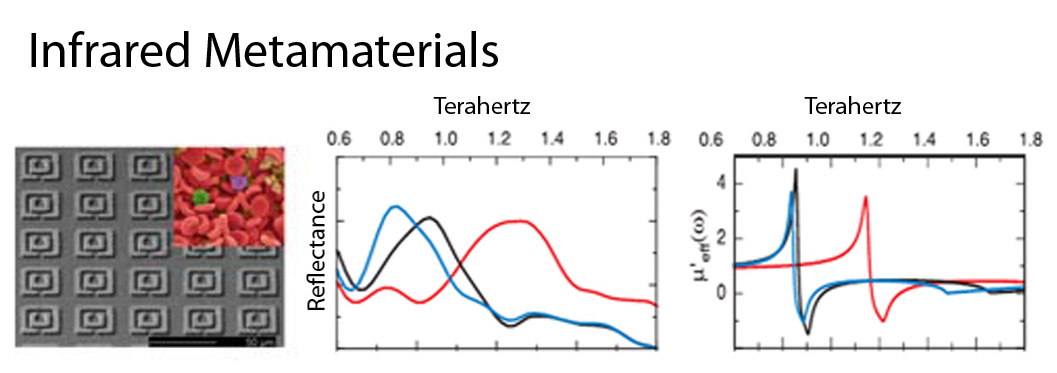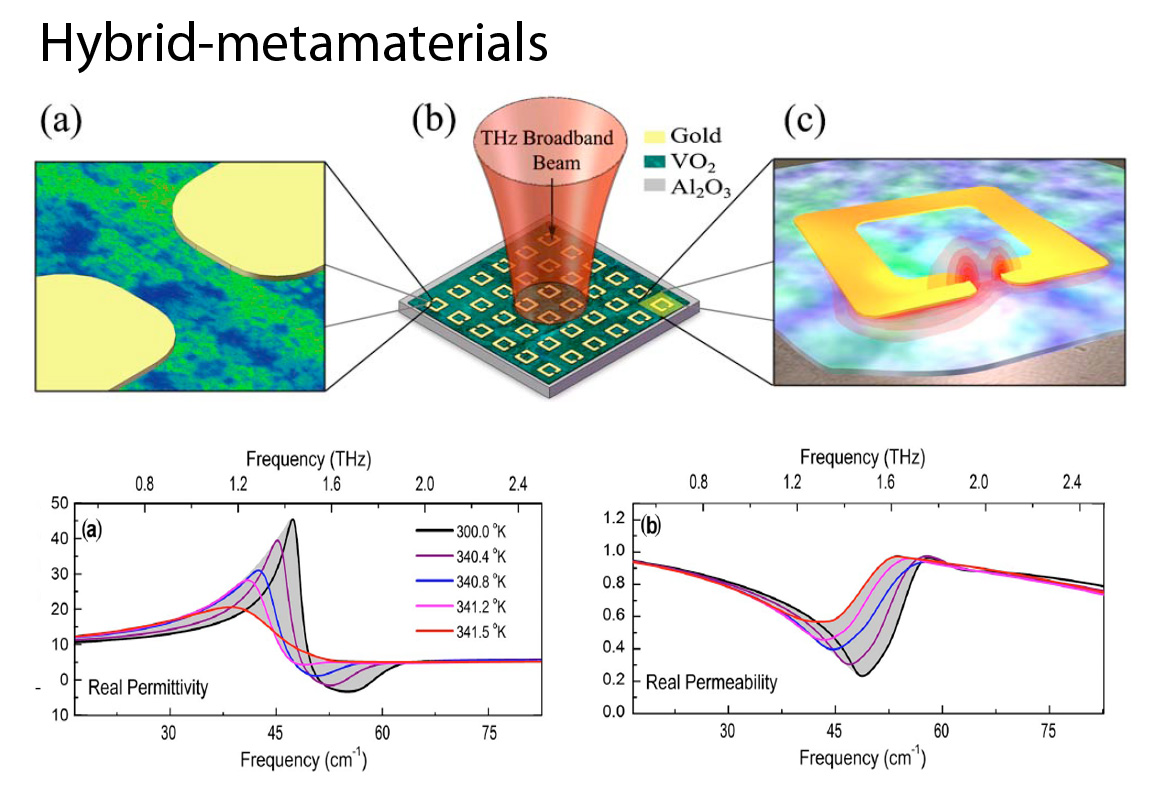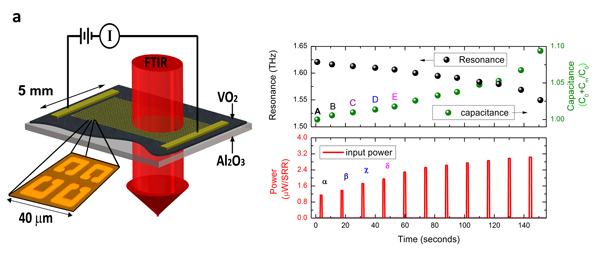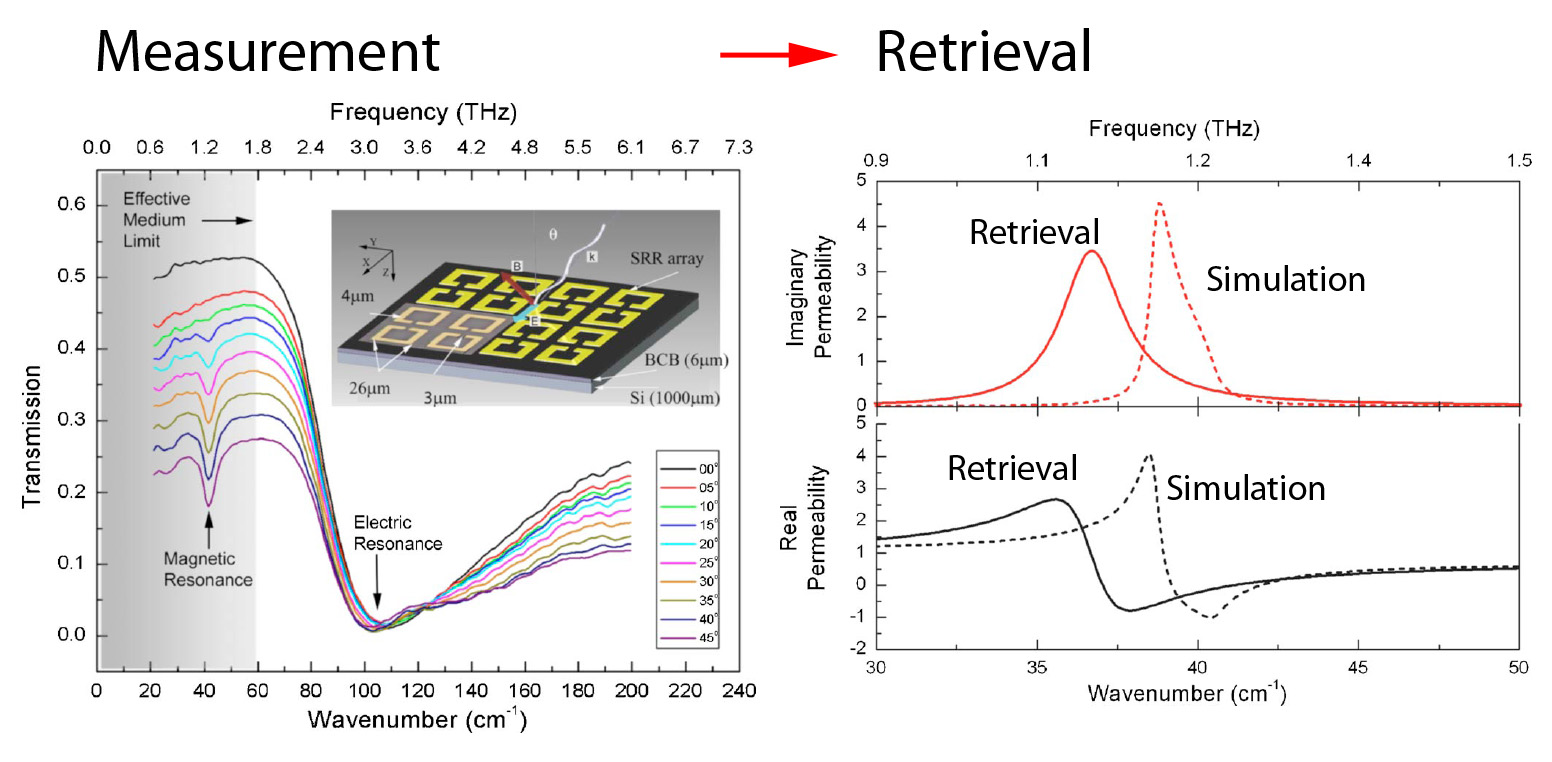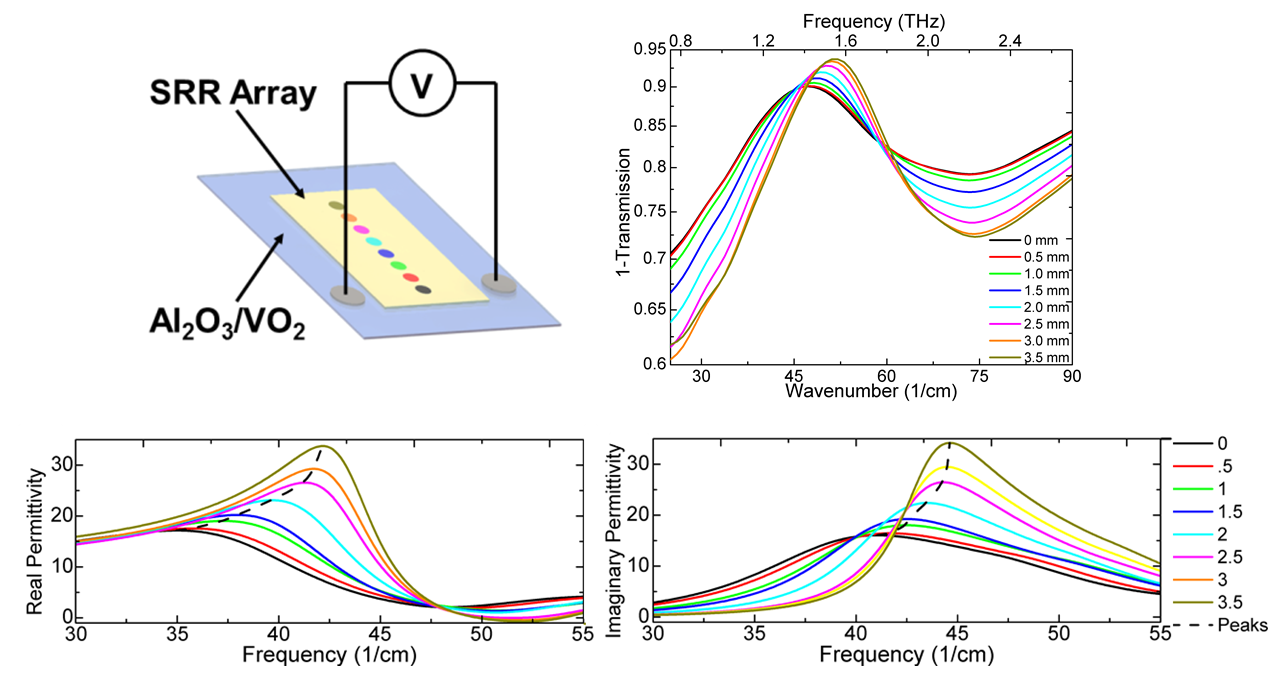| Infrared Nano-Optics of Quantum Materials | |||
|---|---|---|---|
Electromagnetic metamaterialsElectromagnetic metamaterials are man-made materials comprised of structures whose electromagnetic properties are deliberately engineered to offer a range of response difficult or impossible to achieve in naturally occurring materials or composites. Some astounding applications of metamaterials include (but are not limited to); negative index of refraction (where magnetic and electric response are simultaneously negative), "Perfect" (sub-wavelength) lensing, and electromagnetic "invisibility" cloaks. The goal of our metamaterial research in the Basov lab is to better understand the response of metamaterials, to gain better control over their range of achievable electromagnetic responses, and to investigate new uses for these versatile materials. We carry out this work with the help of many collaborators, including D.R. Smith (Duke), X. Zhang (UC Berkeley), N. Jokerst (Duke), W.Padilla (Boston College), A. Starr (Sensormetrix, inc), and S. Nemat-Nasser. Metamaterial work is supported in part by an ONR MURI program (P.I. Z.Celinski (University of Colorado, Colorado Springs), and through an AFOSR MURI. Below we discuss some of our current or recent metamaterial projects. A remarkable aspect of one particular class of metamaterials is the ability to achieve magnetic permeability µ in a structured medium comprised of conducting non-magnetic elements. This attribute has facilitated creation of artificially magnetic materials at high frequencies where natural magnetism is absent. Resonant response of such a medium termed the Left Handed (LH) behavior has been demonstrated at microwave frequencies by D.R. Smith and S. Schultz (UCSD), and at Terahertz (far-infrared), shown below.
The use of a resonant response allows us metamaterials their unique electromagnetic properties, but it also builds in a limited bandwidth. Dynamic-Tuning (the ability to change the attributes of the resonance in real-time) is a great step towards alleviating the limitations of bandwidth. Our group is working on several approaches to this - ranging form integration into electronic FET devices to hybridization of metamaterials with natural materials that possess advantageous properties. Below is results from one such hybrid metamaterial, a Vanadium Dioxide device. Incorporation of a Vanadium Dioxide layer into our metamaterial allows temperature controlled tuning of greater than 20%
Although metamaterial tuning has been demonstrated for many forms of stimulus (light, temperature, mechanical stress, electrical) have been demonstrated, in most, if not all, cases to date the stimulus must be maintained in order to maintain tuning. This can be a disadvantage if many metamaterial unit-cells are to be tuned to differing degrees. Using VO2, we demonstrated a form of electrical persistent tuning. In this configuration tuning of the metamaterial occurs in response to applied electrical voltage, but remains after voltage is removed. The memory apparent in this configuration is a manifestation of memory-capacitance, a phenomena related to memristance.
Metamaterial Response is most easily thought of in terms of the electric permittivity and magnetic permeability responses. However, these attributes are not directly experimentally accessible. Description of the electric and magnetic metamaterial response from measured reflection and transmission is critical to designing and understanding metamaterials. The Basov lab has developed a coded specialized retrieval fitting routine suited for recovering the electromagnetic response of metamaterials from measured reflection/transmission.
Through the combination of the VO2 tuning techniques described above, we have demonstrated the creation of a tunable gradient index of refraction in a previously uniform metamaterial. This was achieved by application of a voltage pulse across the contacts, as shown below, to yield a persistent change in the optical properties due the inclusion of VO2 in the metamaterial design. This gradient occurs because the amount of joule heating differs throughout the device due to variation in the current densities at different distances from the contacts. The results of this work are shown below. Through improved design of contact geometry, finer control of this gradient may be achieved. Current research on these devices focuses on exploring this method of finer control on the creation of these gradients.
Recent publications: 1. M.D. Goldflam, T. Driscoll, B. Chapler, O. Khatib, N. Marie Jokerst, S. Palit, D.R. Smith, B.-J. Kim, G. Seo, H.-T. Kim, M. Di Ventra, and D.N. Basov, Applied Physics Letters 99, 044103 (2011). LINK 2. M. A. Kats, D. Sharma, J. Lin, P. Genevet, R. Blanchard, Z. Yang, M.M. Qazilbash, D.N. Basov, S. Ramanathan, and F. Capasso, Applied Physics Letters 101, 221101 (2012). LINK 3. Driscoll, T., et al. Memory Metamaterials. Science 2009 315,1518 PDF 4. Driscoll, T., et al., Dynamic tuning of an infrared hybrid-metamaterial resonance using vanadium dioxide. Applied Physics Letters, 2008. 93(2): p. 024101. PDF 5. Driscoll, T., et al., Tuned permeability in terahertz split-ring resonators for devices and sensors. Applied Physics Letters, 2007. 91(6): p. 062511. PDF 6. Driscoll, T., et al., Quantitative investigation of a terahertz artificial magnetic resonance using oblique angle spectroscopy. Applied Physics Letters, 2007. 90(9): p. 092508. PDF 7. Driscoll, T., et al., Electromagnetic characterization of planar metamaterials by oblique angle spectroscopic measurements. Phys. Rev. B, 2007. 75: p. 115114. PDF 8. Driscoll, T., et al., Free-space microwave focusing by a negative-index gradient lens. Applied Physics Letters, 2006. 88(8): p. 081101. PDF 9. Ta-Jen Yen, W.J. Padilla, Nicholas Fang, D.N. Basov, D. Vier, D. R. Smith, J.B. Pendry, and Xiang Zhang, “THz magnetic response from artificial materials” Science 303, 1494 (2004). PDF 10. Dongmin Wu, Nicholas Fang, Cheng Sun, Xiang Zhang, Willie J. Padilla, Dimitri N. Basov, David R. Smith, and Sheldon Schultz. "Terahertz plasmonic high pass filter." Appl. Phys. Lett. 83, 201 (2003). PDF |
|||
t |
|||
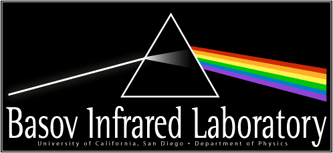 |
|||
